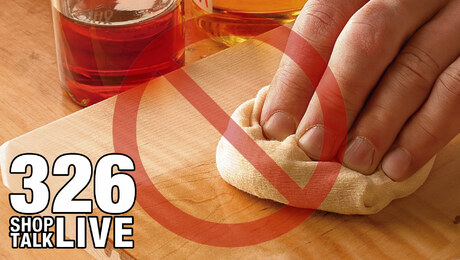STL203: Finding holly for inlaying and banding
Bob, Mike, and Ben discuss sources for holly, what a listener can do with 1/8-in. ebony, how close is close enough when setting up a jointer, and a listener asks how you can prefinish AND soften edges after a piece is assembledQuestion 1:
From Shane:
I have seen many articles for stringing and inlay in your fine magazine, and I am ready to give it a shot. My only problem is, I can’t find anywhere to buy Holly. I live in an area with only basic wood choices. I have searched online, and the only thing I see is on Etsy and I’m not really comfortable with that. Any sources you can share for buying Holly in veneer or solid form?
Question 2:
From Paul:
What do you consider the limit for veneer sheet thickness? I want to glue up 1/8″ thick Gabon Ebony to highly figured 3/16″ thick quartered Koa. These would be the walls of a small box, about 3-6 inches in finished board width. I envision them being glued up in same grain direction (not crossed). Will they delaminate or split? Do I need center ply oriented 90 degrees to these two parallel boards? Along these lines, can you safely veneer of standard thickness (1/42 inch) to a 3/8″ thick board in the same direction?
Segment: All-Time Favorite Technique
Ben: ¼-in. wrench on a screw bit
Mike: Finally changing the tires and bearings on his tablesaw
Bob: Cut half-blind dovetails with the board held flat on the bench
Question 3:
From Michael:
I recently purchased a new (Jet) 8″ jointer and have watched a Youtube video on setup. In that video the presenter goes to extraordinary lengths to make sure the tables are co-planar within 2 thousands of an inch. I don’t understand why. If the Jointer makes the face flat and the planer then creates a parallel opposite side, what difference does it make if the jointer takes a couple of thousands of one side? And when jointing the edge the difference seems insignificant over one or even two inches. What am I missing here?
 |
The Jointerby Bernie Maas |
 |
Jointer Tune-upby John White |
 |
Ep 3a: Machine Setup – The Jointer part 1by Matt Wajda |
Question 4:
From Larry:
In episode 110, you recommended chamfering edges with high grit sandpaper after the piece had been assembled. In subsequent episodes I’m fairly certain it’s been mentioned that it’s a good practice to finish the parts of a piece before assembly, especially if you’re using a film finish. Chamfering an edge after assembly would remove the finish, right? Do you apply a final finish that covers the chamfered edges? I’m confused about these seemingly contradictory recommendations.
 |
|
 |
Recommendations:
Mike: Revisionist History and Broken Record
Ben: Cocaine and Rhinestones and Criminal
Every two weeks, a team of Fine Woodworking staffers answers questions from readers on Shop Talk Live, Fine Woodworking‘s biweekly podcast. Send your woodworking questions to [email protected] for consideration in the regular broadcast! Our continued existence relies upon listener support. So if you enjoy the show, be sure to leave us a five-star rating and maybe even a nice comment on our iTunes page.




















Comments
In the answer to Q4, Ben mentioned he keeps a bottle of seal coat for pre-finish. 4 follow-up questions
1) which specific product is in the seal coat from Zinnser?
2) how do you apply it, given you could be doing some small sections with meaningful time between pieces
3) do you worry much abt dust getting into this finish, given you are doing this on your bench before cleaning up dust in the shop to do final finishing
4) do you worry sanding back down grain raise or just leave it given these are likely not visible surfaces
Love the idea of pre-finishing, just hate finishing in general..the smell, the mess, and the stress. So want to make pre-finishing as easy as possible.
Log in or create an account to post a comment.
Sign up Log in